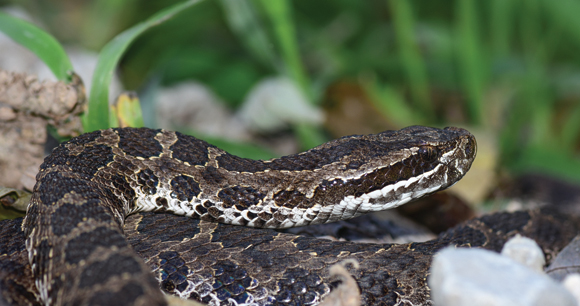Novel Methods to Assess the Population Status of the Eastern Massasauga Rattlesnake
The eastern massasauga is a small rattlesnake that was once widespread and common but is now threatened in approximately 75 percent of its range. It is protected in every state or province where it occurs and is listed as threatened under both the US Endangered Species Act and Canada’s federal Species at Risk Act. Efforts to study the population dynamics and survival of eastern massasaugas have historically been difficult due to cryptic coloring, reclusive behavior, and low recapture rates.

Use of drones to survey wildlife is increasing as both drones and high-resolution cameras become more affordable. Some studies have demonstrated improved count accuracies via drone surveillance over traditional ground-based techniques. Whereas drones are primarily used to quantify conspicuous species, the increased use of aerial thermal imaging has improved detection of cryptic species. The aim of this project was to determine if aerial thermal imaging could increase the detection of eastern massasaugas during their active season (April–September), when they maintain elevated body temperatures for gestation and digestion.
A total of 23 surveys were completed between April and August of 2019. Surveys took place during daylight hours to provide coverage across different sun angles and ambient surface temperatures. Transects were flown at an altitude of 10 meters (about 33 feet) to minimize disturbance. Once a suspected massasauga was spotted, the drone was lowered to approximately 3 meters (about 10 feet), and a 30x optical zoom camera was used to provide confirmation. The snakes did not react to the presence of the drone at either altitude. The Christine Stevens Wildlife Award facilitated the purchase of a second controller and tablet, improving efficiency by allowing the pilot to focus on drone operation while a second operator focused on scanning the thermal imagery.
Using thermal imagery, we were able to successfully detect eastern massasaugas with as little as a 1 degree Fahrenheit increase over ambient ground temperatures. Coiled snakes were easier to detect during surveys due to the unique shape and higher heat retention, while uncoiled snakes were harder to discern, as the prairie contained several similarly shaped objects that retained heat at a higher temperature compared to the ground. Additionally, weather impacted survey results. Cool or overcast days were most conducive to locating massasauga rattlesnakes using thermal imaging. The reduced solar radiation on those days required snakes to seek higher ground for basking, increasing the temperature contrast between the snake and substrate. On hot, full sun days, the snakes’ “solar loading” brings them up to the surrounding substrate temperature, effectively making them invisible to the thermal camera.
Thanks to the support of the Christine Stevens Wildlife Award, this project demonstrated that aerial thermal imaging can be employed as an effective and noninvasive survey technique to detect eastern massasaugas.
This study was funded by the Christine Stevens Wildlife Awards program. Learn more about this program or view additional studies.
Program Terms: Terrestrial Wildlife
AWI Quarterly Terms: Feature Article
Related News
IUCN Reaffirms Long-Tailed Macaques’ Endangered Status Despite Industry Pressure
In Program: Terrestrial WildlifeThe International Union for Conservation of Nature (IUCN) today released an update to its Red List of Threatened Species. The update revealed that the long-tailed...
AWI Funds Research to Alleviate Human-Wildlife Conflicts, Animal Suffering
In Program: Terrestrial WildlifeThe Animal Welfare Institute (AWI) announced today the eight recipients of its Christine Stevens Wildlife Award who are developing humane solutions to human-wildlife conflicts and...
Refuge from Cruel Trapping Act Reintroduced to Protect Wildlife and Pets on Public Lands
In Program: Companion Animals, Terrestrial WildlifeThe Animal Welfare Institute (AWI) endorses the Refuge from Cruel Trapping Act, reintroduced today in the US House of Representatives by Rep. Jerrold Nadler (D-NY)....
Colorado Now Leads Country in Comprehensive Approach to Fighting Wildlife Trafficking
In Program: Terrestrial WildlifeToday, Colorado Gov. Jared Polis signed S.B. 25-168 into law to combat wildlife trafficking. The bipartisan legislation, which is unique among states for the number...